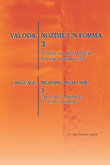Atgriezeniskuma formālie rādītāji latviešu valodā
Reflexivity markers in Latvian
Author(s): Andra KalnačaSubject(s): Language and Literature Studies, Theoretical Linguistics, Phonetics / Phonology, Morphology, Lexis, Baltic Languages
Published by: Latvijas Universitātes Akadēmiskais apgāds
Keywords: atgriezeniskie darbības vārdi; atgriezeniskie vietniekvārdi; atgriezeniskie afiksi; darītājs; cietējs;
Summary/Abstract: Latvian has different types of reflexive markers – the light form – a verbal affix, the heavy form and superheavy form, which are usually pronominal. In Standard Latvian the light reflexive marker is expressed by the final -s in verbal finite and non-finite forms. In Latvian subdialects, in prefixed verbs the light reflexive marker stands between the prefix and the root, e.g., sa-sa¬-runāt ‘to speak’ (Standard Latvian sarunāties) in Couronian subdialects of the Middle Dialect, na-sa-klauseit ‘not to listen’ (Standard Latvian neklausīties) in the High Latvian Dialect. The light marker can occur twice – the element -sa- between the prefix and the root as well as the final s: pa-sa-priecātie-s ‘to be happy’ (Standard Latvian papriecāties), ap-sa-rauduotī-s ‘to start crying’ (Standard Latvian apraudāties’). Heavy reflexive markers in Latvian are attested in the form of the reflexive pronoun sevi (ACC) or sev (DAT): es neieredzu sevi ‘I hate myself’, es nopirku sev grāmatu ‘I bought myself a book’. Superheavy reflexive markers in Latvian take the form of a cluster of two pronominals – the emphatic pronoun pats/pati (NOM) + reflexive pronoun sevi (ACC) or sev (DAT): es neieredzu pats sevi / sevi pats ‘I hate myself (male speaker)’, es nopirku pati sev / sev pati grāmatu ‘I bought myself a book (female speaker)’. Examples with pašu (ACC) and pašam, pašai (DAT) in the cluster of pronominals also attested.
Journal: Valoda: nozīme un forma
- Issue Year: 2013
- Issue No: 3
- Page Range: 57-66
- Page Count: 10
- Language: Latvian

